River Hamble Tides – A sailor’s guide
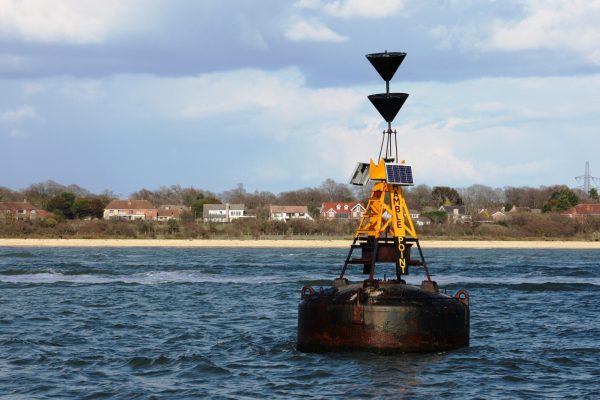
On this page:
1. Introduction
2. Hamble tidal overview & resources
3. Hamble tidal curves
4. Example planning for Port Hamble
1. Introduction
The tides on the Solent and Hamble river are unique – largely because of the peculiar tides we get as water comes round both sides of the Isle of Wight. The varying depths and obstructions within the Solent also create further peculiarities – with a variety of eddies running in different places at different times.
Numerous publications are available that detail tidal streams within the main body of the Solent. In particular, ‘Winning tides’ is a handy waterproof book, ideal for racers and cruisers, who want easy access to tidal information whilst on deck. Available at most chandleries and online stores.
The purpose of this guide is to take a more detailed look at the specific tidal curve of the river Hamble and how to plan your boating/marina handling to avoid the strongest running streams and utilise the frequent periods of slack water that form the rivers tidal curve.
2. Hamble tidal overview and resources
The tides change with the moon, on a roughly 2 week cycle. Spring tides are when the tidal range will be highest, with the lowest low and the highest high. Neap tides are when the tidal range is smallest. The timings of high and low water progress to be later every day by about 40 minutes.
A good rule of thumb to work from is that Spring tides occur with HW at midday/midnight and Neap tides occur with HW at 6am/6pm. The closer the timing of HW to midday/midnight then the stronger the tide.
The speed of the incoming/outgoing tide can be as much as 3 knots in parts of the River, more at the double green posts below Hamble Point Marina. The ebb tide currents are faster than the flood tide currents.
Long range tide tables
Long range tide tables can be hard to find online but a 28 day view for Portsmouth tide times is available via the button below.
PORTSMOUTH TIDE TABLE: 28 DAY VIEW
For complete accuracy, you need to make a small adjustment on the above for Hamble river – but for overview planning purposes it’s not really necessary. Buying the same Reeds Almanac that we provide on the boats (or at least a tide table) from the chandlery can prove to be a useful planning investment.
Short range tide tables
We recommend the following link for short term planning (7 days) and to view/understand the tidal curve on the river Hamble.
HAMBLE/WARSASH TIDE TABLE: 7 DAY VIEW
Use the drop down on the right to view the tidal curve for your chosen date. It’s important to understand the tidal curve specific to Hamble so let’s take a look at two tidal curves (Spring and Neap) to illustrate various points.
3. Hamble tidal curves
Spring tide curve
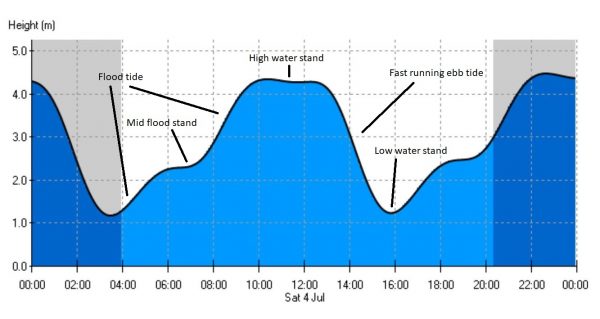
You will see, above, an example curve for Hamble on a Spring(ish) tide. It doesn’t look like the normal sine wave you would expect because of the peculiar tides we get as water comes round both sides of the Isle of Wight.
Three key features are:
• 0600-0730: The mid flood stand where halfway through the incoming tide it stops. Most pronounced on Spring tides, the mid flood stand offers around an hour and a half of slack water. It can be a useful point of the tide for exiting and entering the marina.
• 1000-1300: The HW stand. Again most pronounced on Springs, the HW stand in Hamble includes a twin peak and can provide in excess of two hours of fairly slack water. Again useful for marina manouevering.
• 1600: The LW stand. Far shorter than the HW stand but it remains a useful period of slack water.
Neap tide curve
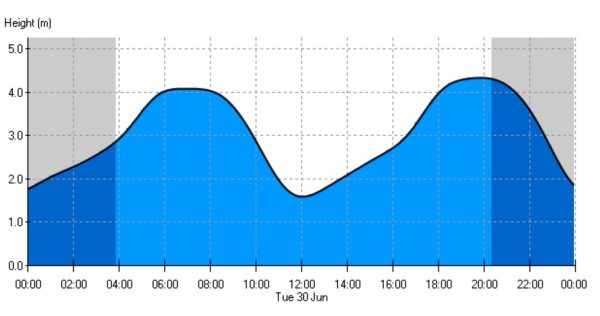
In the above chart you will see a curve for a Neap(ish) tide. You will see that the Low water is much higher at 2.0m and the High water much lower at 3.9m. The gradient of the curves is less steep which tells you that the tidal currents will not be as strong as at a Spring tide.
On the curve above you will see that both the mid flood and HW stands are not as pronounced for Neap tides as for Springs.
4. Example tidal planning for Port Hamble
Particularly as you get started with skippering from Hamble, it’s worth trying to plan your exit and entry to the marina to coincide with slack water. As you build experience and confidence, marina handling with the tidal stream running is a key skill you should be looking to build on.
As with most things in life, drawing hard lines is difficult, but the examples below illustrate our recommendations on how to plan your day around different tidal curves.
Spring tide
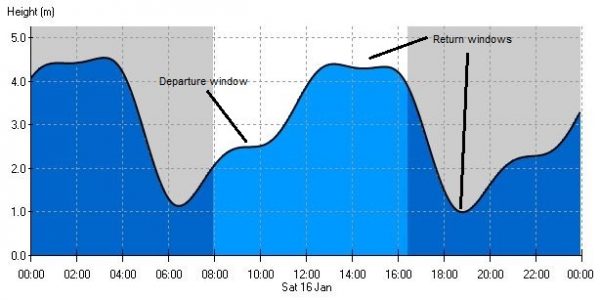
Whilst Spring tides deliver the strongest stream (both in the marina and the Solent) which you may seek to avoid, their timing in Hamble also provides useful windows of slack water. With Spring HW around midday, the mid flood stand occurs around 0830-1030, the HW stand around 1300-1600 and the LW water stand around 1830.
NB. Only experienced skippers who are confident with their marina/ferry gliding skills should plan to return to the marina during the fast running ebb tide 1600-1800. If you’re just getting started, we really don’t recommend it.
Neap tides
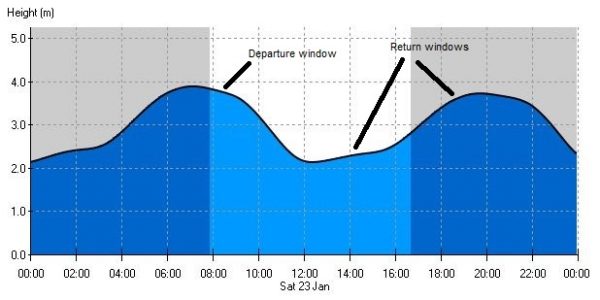
Neap tides deliver the weakest stream and most skippers should be able to depart and return to the marina throughout a Neap curve. However, if possible, it still makes sense to plan your departure and return to coincide with the weakest stream which in the above example is 0700-0900, 1400-1600 and 1830-2030.
NB. The orientation of many of our berths on F pontoon means you will be departing and returning on a Neap with the tide underneath you (albeit the flow is weak). Unless confident in these conditions, we recommend planning your day to utilise the windows of slack water.
Halfway Spring/Neap tide
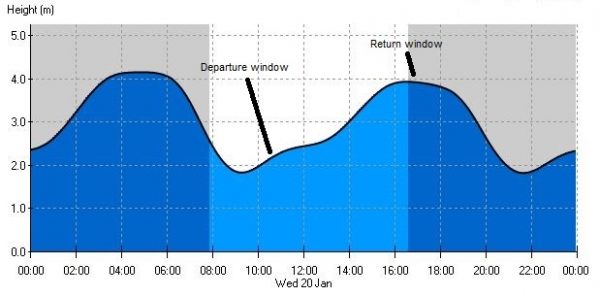
A tide halfway between Springs and Neaps offers the best of both worlds, with moderate tidal flows and convenient departure (0930-1300) and return windows (1600-1800).
NB. There will be a noticeable incoming flow between 1000-1100. For most of our berths on F pontoon this means you will be departing against the tide which most skippers find easier. If you’re just getting started, we recommend departing before 1000 (to take advantage of the last of the LW stand) or waiting until after 1100 (to take advantage of the start of the mid flood stand).
Other considerations
• Picking a tide for easy marina handling is important, but don’t forget you also need to consider the direction of tidal flow in the Solent in line with your passage plans.
• Berth orientation: If parking while the stream is running, most skippers find parking against the tide easier. Therefore you need to consider the orientation of the berth to the tide.
• The tidal stream isn’t your only consideration when boat handling in the marina. You also need to consider the effect of the wind on the boat. This can often be done whilst the boat is tied up and looking at which lines are under strain and working out whether the tide or wind is the predominant force. When returning to the berth, this is trickier but can to some extent be ascertained in the middle of the river by stopping the boat in an area where you have more space. Beware though, because as you drive into the marina the depth will shallow and in some circumstances the tidal flow will lessen. Watching other boats come and go, and thinking through the techniques that worked/failed and why, is also a really valuable exercise.
Progress your skills
Once you have a few trips under your belt and have built confidence with your marina handling in slack water, we recommend booking a training session with a PL instructor to work on close quarters manouveres with the stream running. Done properly with full situational awareness, the stream can be used to your advantage and parking the boat becomes a really enjoyable part of the day!